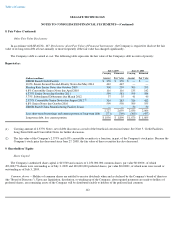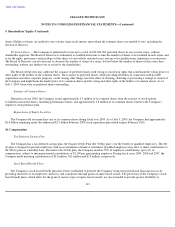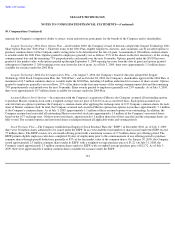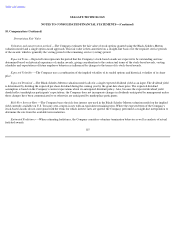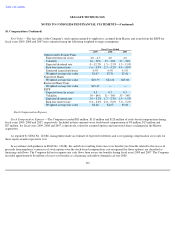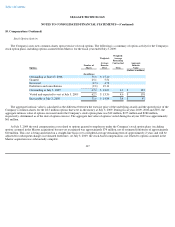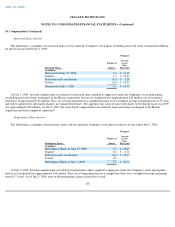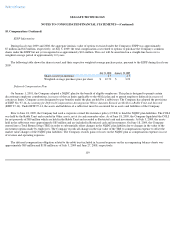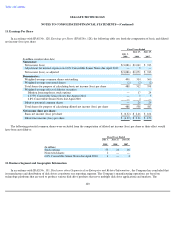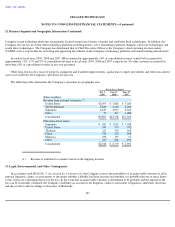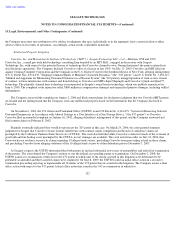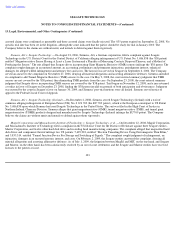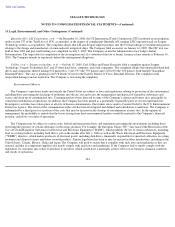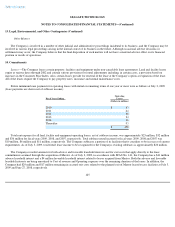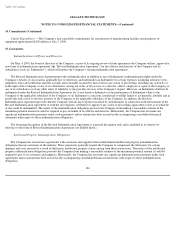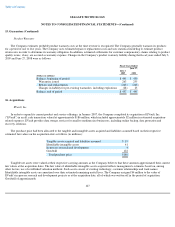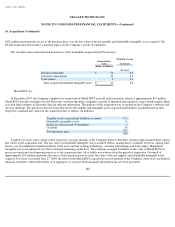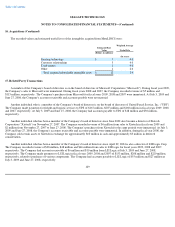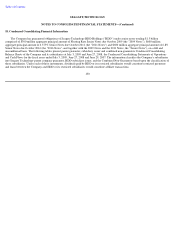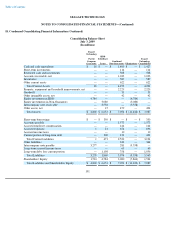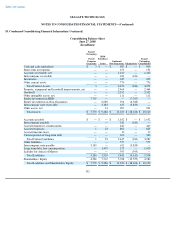Seagate 2008 Annual Report Download - page 124
Download and view the complete annual report
Please find page 124 of the 2008 Seagate annual report below. You can navigate through the pages in the report by either clicking on the pages listed below, or by using the keyword search tool below to find specific information within the annual report.
Table of Contents
SEAGATE TECHNOLOGY
NOTES TO CONSOLIDATED FINANCIAL STATEMENTS—(Continued)
13. Legal, Environmental, and Other Contingencies (Continued)
the Company may enter into settlements or be subject to judgments that may, individually or in the aggregate, have a material adverse effect
adverse effect on its results of operations. Accordingly, actual results could differ materially.
Intellectual Property Litigation
Convolve, Inc. and Massachusetts Institute of Technology ("MIT") v. Seagate Technology LLC, et al —Between 1998 and 1999,
Convolve, Inc., a small privately held technology consulting firm founded by an MIT Ph.D., engaged in discussions with Seagate
Technology, Inc. with respect to the potential license of technology that Convolve claimed to own. During that period, the parties entered into
non-disclosure agreements. The Company declined Convolve's offer of a license in late 1999. On July 13, 2000, Convolve and MIT filed suit
against Compaq Computer Corporation and the Company in the U.S. District Court for the Southern District of New York, alleging infringement
of U.S. Patent Nos. 4,916,635, "Shaping Command Inputs to Minimize Unwanted Dynamics "(the "'635 patent ") and U.S. Patent No. 5,638,267,
"Method and Apparatus for Minimizing Unwanted Dynamics in a Physical System" (the '267 patent), misappropriation of trade secrets, breach
of contract, tortious interference with contract and fraud relating to Convolve and MIT's Input Shaping® and Convolve's Quick and Quiet™
technology. The plaintiffs claimed their technology is incorporated in Seagate's sound barrier technology, which was publicly announced on
June 6, 2000. The complaint seeks injunctive relief, $800 million in compensatory damages and unspecified punitive damages, including willful
infringement.
The Company answered the complaint on August 2, 2000 and filed counterclaims for declaratory judgment that two Convolve/MIT patents
are invalid and not infringed and that the Company owns any intellectual property based on the information that the Company disclosed to
Convolve.
On November 6, 2001, the U.S. Patent and Trademark Office (USPTO) issued US Patent No. 6,314,473, "System for Removing Selected
Unwanted Frequencies in Accordance with Altered Settings in a User Interface of a Data Storage Device." (the '473 patent") to Convolve.
Convolve filed an amended complaint on January 16, 2002, alleging defendants' infringement of this patent, and the Company answered and
filed counterclaims on February 8, 2002.
Plaintiffs eventually indicated they would not prosecute the '267 patent in this case. On March 29, 2006, the court granted summary
judgment for Seagate that Convolve's fraud, tortious interference with contract, unfair competition and breach of confidence claims are
preempted by the California Uniform Trade Secrets Act (CUTSA). The court also held that while Convolve's claim for breach of the covenant of
good faith and fair dealing is not preempted by the CUTSA, no tort damages are available. The court entered an order on July 14, 2006, that
Convolve has no evidence to prove its claims regarding 10 alleged trade secrets, precluding Convolve from proceeding at trial on those claims,
and precluding Convolve from alleging violations of the 10 alleged trade secrets by either defendant prior to December 7, 2005.
At Seagate's request, the USPTO determined that both patents in suit had substantial new issues of patentability and ordered re-examination
of the patents. The court denied the Company's motion to stay the federal case pending patent re-examination. On December 2, 2008, the
USPTO issued a re-examination certificate for the '473 patent in which nine of the claims asserted in this litigation were determined to be
patentable as amended and three asserted claims were confirmed. On June 8, 2009, the USPTO issued an initial office action in a second re-
examination proceeding rejecting as unpatentable all 12 claims of the '473 patent that are asserted in the litigation. The Company awaits a final
office action with respect to the '473 patent A final office action has issued in the '635 re-examination in which five
122


